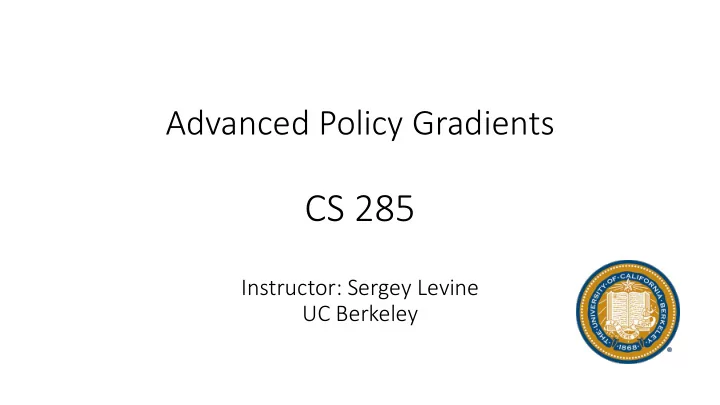

Advanced Policy Gradients CS 285 Instructor: Sergey Levine UC Berkeley
Recap: policy gradients fit a model to estimate return generate samples (i.e. run the policy) improve the policy “reward to go” can also use function approximation here
Why does policy gradient work? fit a model to estimate return generate samples (i.e. run the policy) improve the policy look familiar?
Policy gradient as policy iteration
Policy gradient as policy iteration importance sampling
Ignoring distribution mismatch? ? why do we want this to be true? is it true? and when?
Bounding the Distribution Change
Ignoring distribution mismatch? ? why do we want this to be true? is it true? and when?
Bounding the distribution change seem familiar? not a great bound, but a bound!
Bounding the distribution change Proof based on: Schulman, Levine, Moritz, Jordan, Abbeel . “Trust Region Policy Optimization.”
Bounding the objective value
Where are we at so far?
Policy Gradients with Constraints
A more convenient bound KL divergence has some very convenient properties that make it much easier to approximate!
How do we optimize the objective?
How do we enforce the constraint? can do this incompletely (for a few grad steps)
Natural Gradient
How (else) do we optimize the objective? Use first order Taylor approximation for objective (a.k.a., linearization)
How do we optimize the objective? (see policy gradient lecture for derivation) exactly the normal policy gradient!
Can we just use the gradient then?
Can we just use the gradient then? not the same! second order Taylor expansion
Can we just use the gradient then? natural gradient
Is this even a problem in practice? (image from Peters & Schaal 2008) Essentially the same problem as this: (figure from Peters & Schaal 2008)
Practical methods and notes • Natural policy gradient • Generally a good choice to stabilize policy gradient training • See this paper for details: • Peters, Schaal. Reinforcement learning of motor skills with policy gradients. • Practical implementation: requires efficient Fisher-vector products, a bit non-trivial to do without computing the full matrix • See: Schulman et al. Trust region policy optimization • Trust region policy optimization • Just use the IS objective directly • Use regularization to stay close to old policy • See: Proximal policy optimization
Review • Policy gradient = policy iteration • Optimize advantage under new policy state distribution fit a model to • Using old policy state distribution optimizes a estimate return bound, if the policies are close enough generate • Results in constrained optimization problem samples (i.e. run the policy) • First order approximation to objective = gradient ascent improve the policy • Regular gradient ascent has the wrong constraint, use natural gradient • Practical algorithms • Natural policy gradient • Trust region policy optimization
Recommend
More recommend